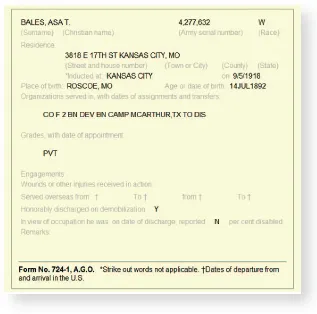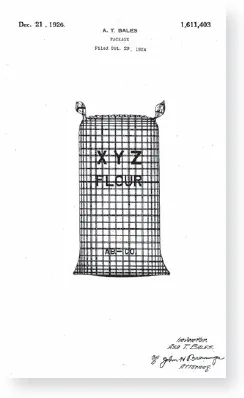![]()
The Father of the Dress Print Bag
On April 28, 1922, The Washington Post announced, “Farewell to the Old Flour Sack.” Big millers thought it a good idea to replace five-pound flour sacks with paper cartons. Cartons would be more convenient to handle and make storage easier for the city housewife. In just a few short years, however, both city and rural housewife would see the old flour sack in a new light. Changes were coming, thanks to a young man named Asa T. Bales.
Asa Theodore Bales was born in Roscoe, Missouri, on July 14, 1892. He was the only child of Alva Jane and Charles H. Bales. In the early 1900s, the Bales family lived in Kansas City, owned a house and had occupations typical of the time. Charles was employed as a streetcar motorman, and Alva worked at home as a seamstress. Seventeen-year-old Asa held the position of salesman in a music store.
The years passed and Asa fell in love with a young woman from Missouri. He and Allene Ballen were married on October 16, 1913. Before the newlyweds could celebrate their first anniversary, the world was embroiled in war. In April of 1917, the United States declared war on Germany and shortly thereafter passed the Selective Service Act, requiring all male citizens between the ages of twenty-one and thirty to register for military service. The few details known about Asa’s appearance are written on his military registration card. He is described as tall and slender with dark hair and brown eyes. His occupation is listed as Branch Manager of Southwest Milling Company.
Allene and Asa had a son in February of 1918. It was undoubtedly a stressful time for the young couple. The war still raged and Asa received notice to report to the Army. He was inducted in late summer and sent to Camp McArthur, Texas, where he served until being discharged.
The following year was not a happy one for Asa and Allene. By the time the January 1920 census was taken, they had separated. Asa was living in his parents’ house in Kansas City. The same census lists Allene and baby Robert with her parents in Carroll County, Missouri.
Registrar’s report with Asa’s physical description.
Asa T. Bales draft registration card.
Missouri State Archives’ World War I service record for Asa T. Bales.
The Invention
World War I was finally over and the country entered the Roaring Twenties. Changes were many and for the better in wages, technology, public health, science, literature and art. It was an exciting time with new ideas. Asa had a new idea, too, and filed a patent for it in October of 1924. The patent read, in part:
“Certain commodities, such as flour, are put in sacks of textile material and such sacks are provided with characters designating the trade mark or brand and the manufacturer, jobber, or dealer. Such sacks, however, usually serve no useful purpose, except that of holding the product for shipment or until used.
One of the objects of this invention is to provide a package having a sack, the cloth of which is adapted to be used for dress goods after the product has been removed or consumed.”
The application went on to detail the sack should be “of a size suitable of being remade into clothing” and “with a substantially indelible or permanent pattern.” The preferable pattern would be cotton gingham “having stripes or checks in two or more colors.” Markings such as the company name should be of ink that would wash away so the cloth could be used for making dresses or other clothing items.
Asa Bales assigned the patent to George P. Plant Milling Company of St. Louis, Missouri, who moved quickly to put the pretty sacks in the hands of the consumer. Gingham Girl, in a variety of colors and featuring a charming southern belle, was introduced through the pages of The Northwestern Miller on April 15, 1925, in this announcement:
The drawing submitted by Bales when applying for his patent in 1924
Gingham Is Used for Flour Sacks: George P. Plant Milling Co., St. Louis, Employs a Novel Idea in Marketing New Flour
In an attempt to get away from the customary methods of merchandising flour, wherein quality, ash and protein content, service, co-operation and like points are the principle selling arguments advanced by the great majority of mill representatives, the George P. Plant Milling Co., St. Louis, has introduced on the market flour packed in gingham sacks, and registered under the Gingham trademark.
To bring out the individuality of the flour in such a way that the housewife will immediately recognize the outstanding characteristics of that flour and demand it is difficult, not only because of the similarity in the quality of flours, but also because of the frequent sameness in flour packages. In explaining the reasons for the adoption of gingham cloth for flour sacks and the accompanying Gingham trademark, E. L. Stancliff, general manager of the company, said:
“We have tried to get away from the old commonplace method of selling flour. The great mistake we millers have made in the past has been the general custom of discussing flour grades and flour markets with the dealer instead of placing our entire emphasis upon developing a kind of flour and a merchandising plan that will assure the dealer a profit.
“We have all been guilty of selling just flour by grades, comparing one flour with another and getting the flour merchant’s mind centered on a kind of flour instead of upon new ideas that will make money for him.”
The trademark for the new sack is Gingham, under which come a number of different brands, of which the principal one is Gingham Girl. Others are Mother Gingham, Baby Gingham and Gingham Queen. These brands, and others, have already gained a wide distribution and are well established in several markets.
Before starting the merchandising of Gingham brands the Plant company saw to it that its trademark was protected in every way. The use of gingham for flour bags is protected by registrations, patents and copyrights, which are the sole property of the George P. Plant Milling Co. The company has also secured the only other registration covering gingham for a food package ever made, and the only other flour mill that has ever used gingham sacks has recognized Plant’s prior and exclusive rights, withdrawn its brands from the market and assigned its business, on gingham packed flour, to the Plant company.
Bread, pastry and fancy cake flour are being packed under the Gingham brands. The gingham used in the sacks, as can be seen from the accompanying illustrations, is of a small check. Other standard gingham patterns are also used. The principal colors are pink and white and blue and white, although some brands are packed in sacks in which green, brown and other colors are used over a white background.
The printing on the gingham sacks is done by a special patent process, using soluble vegetable inks, so that the brands will rinse out with the use of regular laundry soap and water. This leaves a plain piece of gingham, its size dependent upon the size of the flour sack purchased, a circumstance that appeals strongly to the housewife, for the gingham thus obtained can be used for making dresses, aprons, rompers and a number of other useful articles.
Gingham flour sacks were introduced in the pages of The Northwestern Miller. “The principal colors are pink and white and blue and white, although some brands are packed in sacks in which green, brown and other colors are used over a white...








